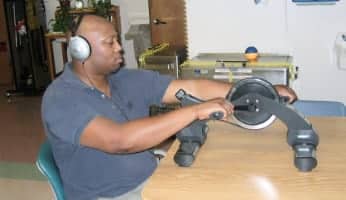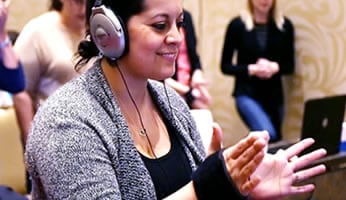Emma’s Transformation: Making Eye Contact and Recognizing Loved Ones

Home - Testimonials - Pediatric Testimonials - Emma’s Transformation: Making Eye Contact and Recognizing Loved Ones

Emma’s Transformation: Making Eye Contact and Recognizing Loved Ones
Emma is an 18 month old little girl referred to our facility in early 2006 for a speech language evaluation. Emma’s diagnoses include Aicardi Syndrome, Agensis of the Corpus Callosum (complete), seizure disorder, cerebral palsy, failure to thrive and global developmental delays.
Mother reported that Emma’s specialists had predicted that “best-case scenario, Emma might one day sit unsupported” and that her family should not develop expectations beyond that.
The family had been advised to equip their home for wheelchair access and to plan on life-long, one-on-one care for Emma.
Emma was referred to our Speech Therapy Clinic due to communication delays and severe sensory integration deficits.
Initial Evaluation
At the time of initial evaluation Emma was 7 months old and her mother reported that Emma displayed only one vocal sound, cried only when in pain, exhibited a severe startle reflex and appeared to have limited visual skills.
Results of a language assessment indicated an age equivalency of 4 months for receptive language and a 2-3 month age equivalency for expressive language.
Creating The Treatment Plan
A plan of treatment was begun utilizing traditional pre-linguistic therapy modalities including oral motor stimulation, introduction of cause/effect toys, prompting of imitation and numerous sensory integration techniques.
Emma was reassessed at 18 months.
Results of that assessment indicated a minimal gain with a standard score of 67, %=1 in auditory comprehension and a standard score of 60, %=1 in expressive comprehension for an overall age equivalency of less than 10 months.
Emma’s mother described her as “a floppy rag doll” who slept 18-20 hours a day and exhibited no desire for interaction or contact with any other person. She reported that she was unable to kiss Emma due to hypersensitivity on her face, hands and feet.
At 18 months Emma would refuse any food other than her baby formula. Mother described Emma’s sensory deficits in feeding as “the three Ts” (temperature, taste and texture) and reported that any change to the “Ts” would result in a total rejection by Emma and typically she would get so upset as to vomit.
At 18 months Emma’s functional deficits included:
- total lack of core and trunk tone
- inability to sit unsupported
- total lack of prone positioning
- no protective balance reflex
- no step reflex
- no crossing of midline
- no reach/grasp behaviors
- no pincher grasp
- limited visual tracking
- no eye contact
- frequent rocking and head banging
- limited and infrequent sound productions with low volume (whispers)
Emma displayed very limited localizations to her name and visually seemed only to fixate on large geometric color blocks.
Based on our clinical experience with Interactive Metronome (IM), past successes in modifying the program to include hand-over-hand assistance, knowledge of the neuro rehabilitative basis of the program and most profoundly, a sincere motivation to achieve the best possible outcome for this sweet little girl, lead us to propose IM as a therapeutic modality to Emma’s parents.
Though (they later admitted) doubtful of the potential for improvements, they felt they had “nothing to lose” and agreed to “try it and see.”
Introduction of IM to The Treatment Sessions
Due to Emma’s severe hypersensitivity to touch, startle reflex and aversion to sound making toys/equipment, we began IM using stereo speakers rather than headphones. Initial sessions were no more than 10-15 minutes working primarily on hand movements. Because of insurance restrictions, Emma was seen only twice weekly.
Though more than one therapist worked with Emma, we would typically hold her in our lap facing away from us and would hold her hands in ours. This positioning allowed the therapist not only to comfortably support Emma upright in a sitting position but also to move her hands while holding the trigger securely in her palm. Emma was completely flaccid and offered no resistance.
We incorporated individual right and left hand movements into our sessions with Emma still seated in the therapist’s lap and maintained approximately the same task average.
Immediate Results
Emma’s mother reported that after the first IM session Emma laughed out loud. She related that Emma was lying on the living room floor while her parents were in the next room. They heard a noise and rushed back in to the room to find Emma looking at the TV and laughing. They had never heard Emma make a noise above a whisper much less look at the TV.
Though they were hesitant to attribute the laughing to IM they continued to see new behaviors after each IM session.
Emma’s sensory issues began to improve dramatically.
We were able to progress Emma to wearing the headphones draped loosely around her neck for very short periods, initially for 1-2 minutes and eventually to wearing them on her ears for the entire session. We found that she more easily accepted the larger, padded headphones which surrounded her ears rather than the type that rest on them.
To complete exercises involving her toes, heels, and cross-over (hand/toe); we positioned Emma in her mother’s lap facing the therapist. We sat on the floor and completed the exercises with two hand triggers wrapped around Emma’s shoes.
As our sessions evolved, Emma became more responsive, extending her hand to have the trigger strapped on, making eye contact as the therapist talked or sang to her during the exercises and would try to assist in making the movements.
She would turn her cheek for a kiss rather than shying away from the touch.
Emma would finally take a sippy cup and in fact would take any sippy cup, not just one particular style or brand. She began to eat some soft table food and would drink water and juice.
Emma was sitting unsupported and her physical and occupational therapists were reporting amazing improvements including a rudimentary crawl.
She developed a moderate righting/balance reflex, had begun some bearing of weight on upper and lower extremities, was crossing midline and using a pincher grasp.
From a cognitive/communication stand point Emma was improving by leaps and bounds. After just 3 IM sessions her mother reported a marked increase in Emma’s babbling and vocal volume. She consistently localized to her name and familiar people and displayed a direct imitation of speech sounds such as mouthing “Momma” and “bye-bye.”
Emma now makes and maintains eye contact, smiles and shows emotion.
Her startle reflex is greatly reduced and she is totally non-defensive when her feet or hands are touched.
Recognizing Her Father For The First Time
The most touching of the reports from the family came from Emma’s father who is a Navy sailor. He went on extended sea duty just after we began using IM with Emma and returned 3 months later. After spending two days at home with Emma, he tearfully said “for the first time ever, she knows who I am. She recognizes me when she sees me.”
We discontinued IM after 5 months with plans to continue at a later date. Emma is still seen in our clinic and is walking with a gait trainer, learning sign language and is enrolled in special education classes with our school district.
Everyone in Emma’s life can testify to the global improvements she made as a result of IM. Intense language therapy is now the goal in order to teach hierarchical skills to her improved neurological pathways.
The Value of IM for Therapists
We would encourage any therapist working with a neurologically involved client to consider IM. Using IM as a therapy tool for Emma has greatly altered our way of evaluating the candidacy of a client. We no longer feel that the client must be of a specific age and/or able to use the program on a progressive, independent basis. We have seen that the brain networks as a result of motor movements and timing regardless of who supplies the responses.
We make no promises to parents who are pursuing IM as a part of their child’s therapy because every little brain is different and every child displays their own unique characteristics.
But for the most part, parents are willing to try most anything to help their child and when told the story of Emma they are excited about the possibilities.
Have fun fellow therapists! We CAN change the lives of children and their families.
Lucy Barlow CCC-SLP, RIMC




